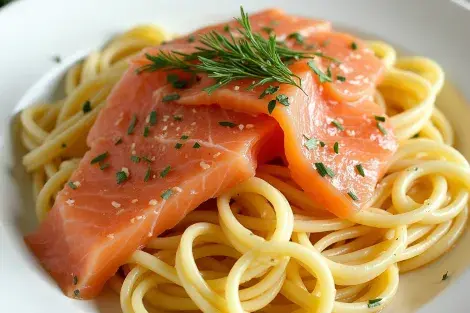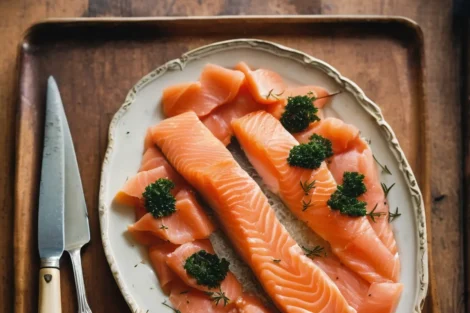How to Smoked Salmon, Smoking salmon is an age-old technique that enhances its flavor, texture, and shelf life. Mastering this method brings out the fish’s natural richness, delivering an unforgettable taste. This guide covers everything you need to know about smoking salmon, from preparation to the final taste test.
Table of Contents
1. Introduction to Smoked Salmon
Smoked salmon has a rich history, tracing back to ancient times when people preserved fish by smoking it. Today, smoked salmon is a delicacy, offering a unique flavor that’s ideal for appetizers, main dishes, or snacks. Smoking enhances the texture of salmon, and depending on the technique, it can yield either a flaky or a buttery, silky result.

2. Tools and Equipment Needed
To achieve the perfect smoked salmon, you’ll need the following tools:
- Smoker (electric, charcoal, or pellet smoker)
- Wood Chips (alder, hickory, apple, or cherry are popular for salmon)
- Thermometer (very necessary to monitor the internal and external temperature of the smoked salmon)
- Large container or plastic bag (for brining)
- Cooling rack (to allow air circulation around the fish)
3. Choosing the Right Salmon
The quality of your smoked salmon depends on the type of fish you start with. Fresh, high-quality salmon is key. There are several options to consider:
- Wild-caught vs. farm-raised: Wild salmon tends to be leaner and has a more pronounced flavor, while farm-raised salmon is often fattier, which can enhance the smoky taste.
- Varieties of salmon: King salmon is known for its richness, while sockeye has a deeper color and more robust flavor. Because that’s the thing that sweetens your taste buds.
Preparing the Salmon Fillet
To prepare the fillet, ensure that any bones are removed and that the skin remains intact (it will hold the fillet together during smoking). Trim away any ragged edges, as these can dry out more quickly and may become overly smoky.
4. Brining: The Key Step
Brining is essential in smoking salmon, as it locks in moisture and enhances flavor. There are two main types of brines: dry brine and wet brine.
Dry Brine
Dry brine is a mixture of salt and sugar (often with spices added). Here’s a basic dry brine recipe:
- 1 cup of kosher salt
- 1 cup of brown sugar
- Optional: black pepper, garlic powder, or herbs like dill.
Rub this mixture generously over the salmon fillet, then let it sit in the fridge for 4-6 hours. Rinse it off and pat dry.
Wet Brine
A wet brine consists of a saltwater solution. For a classic wet brine:
- 4 cups water
- 1 cup kosher salt
- 1 cup brown sugar
Submerge the salmon in the brine for 8-12 hours in the refrigerator. Rinse, then pat dry.
5. Types of Smoking (Hot and Cold Smoking)
Hot Smoking
Hot smoking cooks the fish at a temperature range of 120-180°F, making the salmon flaky and fully cooked. It’s ideal for those who want a ready-to-eat product that doesn’t require further preparation.
Cold Smoking
Cold smoking is a more delicate process where the salmon is smoked at temperatures below 90°F. This method infuses a smoky flavor without fully cooking the fish, resulting in a smooth, silky texture. Cold smoking requires more careful temperature control and additional curing steps.
6. Smoking Process
Step-by-Step Guide
- Prepare the Smoker: Preheat the smoker to the desired temperature, depending on whether you’re hot or cold smoking. For hot smoking, try to start at 150°F.
- Add Wood Chips: Use a mild-flavored wood like alder or apple for salmon. Stronger woods can overpower the delicate fish.
- Arrange the Salmon: Place the salmon on the cooling rack with skin side down, ensuring airflow around each piece.
- Monitor Temperature: Insert a thermometer probe into the thickest part of the fish. For hot smoking, maintain a temperature of 145°F for at least 30 minutes.
- Smoking Time: Smoking times can vary. Hot smoking may take 2-4 hours, while cold smoking can take up to 24 hours.
- Check Doneness: Hot smoked salmon should reach an internal temperature of 145°F. For cold smoked, ensure it’s infused with smoke flavor without overheating.
7. Storing and Serving Smoked Salmon
Smoked salmon can be stored in the fridge for up to a week or frozen for longer storage. Be sure to wrap it tightly in plastic wrap and place it in an airtight container to retain freshness.
Serving Ideas:
- As-is with capers and red onions: Serve smoked salmon with a squeeze of lemon, capers, and thinly sliced red onions.
- On a bagel with cream cheese: This classic combination is perfect for brunch.
- Salmon salad: Combine flaked smoked salmon with greens, avocado, and a tangy vinaigrette.
8. Tips for Doing It
- Control the temperature carefully: Consistent heat is crucial, especially for cold smoking.
- Experiment with flavors: Add herbs, spices, or different types of wood for custom flavors.
- Practice patience: Smoking is a slow process, but the rich flavors are worth the wait.
9. Troubleshooting Common Issues
Smoking salmon can be a bit tricky, especially for beginners, and it’s normal to encounter a few common issues along the way. Here are solutions to some frequent challenges:
How to Smoked Salmon: Salmon is Too Salty
Overly salty salmon usually results from an extended brining time or a brine with too high a salt concentration.
- Solution: Rinse the salmon thoroughly after brining, and consider soaking it in fresh water for a few minutes before drying. You can also adjust the salt content in the brine by reducing the amount slightly.
How to Smoked Salmon: Salmon is Too Dry
Dry salmon may occur if it’s smoked for too long, or at too high of a temperature.
- Solution: Maintain consistent, low temperatures. For hot smoking, aim to keep the smoker around 150°F for the majority of the smoking process, only raising it slightly towards the end. Using a water pan in the smoker can also help retain moisture.
Uneven Smoke Penetration
If parts of the salmon lack smoky flavor, it may be due to inconsistent airflow or improper arrangement in the smoker.
- Solution: Ensure the fish pieces have adequate space around them to allow the smoke to circulate evenly. Use a rack or perforated tray to encourage airflow.
Too Strong or Bitter Smoke Flavor
This can happen if too much wood is used, or if strong woods like mesquite or hickory are used without restraint.
- Solution: Use mild, fruit-based woods like apple or cherry, and avoid overloading the smoker with chips. Let the wood burn down a bit before adding the salmon to avoid overly intense flavors.
10. Experimenting with Flavors and Marinades
While traditional brines focus on salt and sugar, experimenting with different marinades and flavors can make your smoked salmon unique.Below are some ideas you can try:
- Maple and Bourbon: Add a splash of bourbon and a bit of maple syrup to your brine for a sweet, caramelized touch with a hint of depth.
- Lemon and Dill: A classic pairing, lemon zest and dill add brightness and freshness to the smoke. You can sprinkle lemon zest and fresh dill over the salmon after brining.
- Spicy Cajun: For a kick, add cayenne pepper, paprika, and garlic powder to the dry brine. This will infuse the salmon with bold, spicy flavors.
Each of these variations adds a different dimension to your smoked salmon, making it versatile for use in salads, on sandwiches, or as a standalone treat.
11. Health Benefits of Smoked Salmon
Smoked salmon is not only delicious but also packed with nutrients. It’s an excellent source of high-quality protein and omega-3 fatty acids, which are beneficial for heart health, brain function, and inflammation reduction. Additionally, smoked salmon contains essential vitamins and minerals like vitamin D, B vitamins, and selenium.
How to Smoked Salmon :Nutritional Considerations
While smoked salmon is nutritious, it can be high in sodium due to the brining process. Those on a low-sodium diet should consume it in moderation or rinse the fish to reduce some of the salt. Pairing smoked salmon with fresh, potassium-rich foods like avocados or leafy greens can help balance out the sodium content.
12. Advanced Smoking Techniques
Once you’ve mastered the basics of smoking salmon, you may want to experiment with advanced techniques for a more nuanced flavor:
- Double Smoking: Smoke the salmon once, let it rest, then smoke it a second time. This intensifies the smoky flavor, ideal for those who prefer a bolder taste.
- Wood Blending: Try blending different types of wood chips, such as combining apple and cherry or alder and pecan, to create a layered flavor profile.
- Longer Curing Times: Extended curing (up to 24 hours) before smoking can create a firmer texture and enhance the flavor depth, especially if you plan to cold smoke the salmon.

13. Using Smoked Salmon in Recipes
Smoked salmon is incredibly versatile and can be the star ingredient in a variety of recipes. Here are a few ideas to make the most of your smoked fish:
- Smoked Salmon Pasta: Toss smoked salmon with cream sauce, capers, and fresh herbs over pasta for a luxurious main course.
- Smoked Salmon and Avocado Toast: Layer smoked salmon on avocado toast with a sprinkle of sesame seeds and chives for a quick, flavorful breakfast.
- Smoked Salmon Sushi Rolls: Roll smoked salmon with avocado, cucumber, and rice in seaweed sheets for a unique twist on sushi.
Each of these dishes highlights the salmon’s smoky flavor, offering a delicious way to enjoy your homemade creation.
14. Final Thoughts: how to Smoked Salmon Best Technique
Smoking salmon is both an art and a science, requiring patience, practice, and a willingness to experiment. With each attempt, you’ll develop a deeper understanding of the process, learning to adjust based on the type of salmon, weather conditions, and smoker setup.
In time, you’ll find the perfect balance of brining, smoking, and flavoring, creating smoked salmon that’s uniquely yours. So, fire up the smoker, select your favorite wood, and get ready to enjoy the fruits of your labor with each savory, smoky bite!

How to Smoked Salmon :
1. Choosing the Right Wood for Flavorful Results
The wood you choose for smoking greatly affects the final taste of your salmon. Lighter woods, like alder and apple, add a subtle, delicate smokiness, enhancing the salmon’s natural flavor without overpowering it. If you prefer a slightly bolder taste, cherry wood offers a fruity sweetness that pairs beautifully with the rich texture of salmon. Avoid stronger woods like hickory or mesquite, as they can be too intense and risk creating a bitter taste.
2. Ensuring Consistent Smoke Flow
Proper airflow is crucial for evenly smoked salmon. Whether you’re using a traditional smoker or a modern electric one, make sure the vents are positioned correctly. Aim for a steady, gentle smoke that flows around the salmon, fully infusing it. This balanced circulation prevents uneven smoking and avoids any burnt or bitter spots.
3. Adjusting Brine Ratios for Flavor Control
The right brine balance is essential to maintain the salmon’s flavor. While the basic brine includes salt and sugar, experiment with slight variations. For instance, you can decrease the salt slightly for a milder taste, or add a touch of honey or maple syrup for a subtle sweetness. These adjustments allow you to create a personalized flavor that perfectly complements the smoky undertones.
4. Experimenting with Spice Blends for Custom Flavors
While classic smoked salmon often relies on salt and sugar, adding spices can elevate its complexity. Try a Cajun blend with paprika and cayenne for a kick, or a Mediterranean mix with oregano, rosemary, and lemon zest for an herby touch. These spice blends infuse new layers of flavor, making each bite unique and memorable.
5. Avoiding Over-Smoking for Perfect Texture
Over-smoking can dry out the salmon and lead to a harsh, bitter taste. For optimal results, keep smoking sessions on the shorter side, especially for delicate, lean fish like wild-caught salmon. Remember, it’s always possible to add more smoke if needed, but removing an excess of it is difficult, so err on the side of caution.
6. Maintaining Ideal Temperature Stability
Temperature consistency is one of the most important factors for quality smoked salmon. For hot smoking, aim for 150°F for the initial phase, gradually increasing to 160°F towards the end. If cold smoking, keep it below 90°F for a more refined texture. A thermometer is essential here, as even slight temperature fluctuations can impact both the taste and safety of your smoked salmon.
7. Using a Water Pan for Moisture Retention
A water pan in your smoker helps to regulate humidity, which prevents the salmon from drying out. This is especially useful for hot smoking, as it keeps the fish moist and juicy. Additionally, it creates a smoother, more evenly distributed smoke, resulting in a well-rounded flavor throughout the salmon.
8. Marinating vs. Brining for Different Flavor Profiles
While brining is traditional for smoked salmon, marinating can add an extra dimension. Try a soy-based marinade with ginger and garlic for an Asian-inspired flavor. Marinate the salmon before brining, then smoke it as usual. The marinade will caramelize slightly, creating a richer, more complex profile in the final product.
9. Enhancing the Texture with Overnight Curing
For a more firm, evenly textured smoked salmon, consider curing the fish overnight after brining and before smoking. Place it on a rack in the refrigerator uncovered; this drying process, known as forming the “pellicle,” creates a sticky surface on the salmon that attracts smoke better and locks in flavor.
10. Trying Different Cuts of Salmon
Different cuts of salmon provide varied textures. For example, belly cuts are rich and buttery, while center cuts are firmer and uniform. Experiment with various cuts to see which ones best fit your preferences and smoking style. The belly cuts are ideal for cold smoking due to their natural fat content, while center cuts work well for hot smoking, creating a consistent, flaky texture.
11. Avoiding Smoke Buildup for Cleaner Flavor
Too much smoke concentration in the smoker can lead to an overpowering, bitter taste. To avoid this, allow fresh air to flow into the smoker by partially opening the vents occasionally. This clears old smoke, making sure that only clean, fresh smoke surrounds the fish, resulting in a light, appealing smoky flavor without any harshness.
12. Choosing the Right Time of Day for Smoking
Environmental conditions, such as temperature and humidity, can influence the smoking process. Cooler mornings or late evenings are ideal, as they provide a stable environment. This is especially important for cold smoking, where lower ambient temperatures help maintain control and ensure that the fish doesn’t accidentally cook.
13. Finishing Touches with Herbs and Fresh Ingredients
After smoking, garnish your salmon with fresh herbs like dill, parsley, or chives. A squeeze of lemon juice or a sprinkle of black pepper enhances the smoky flavor without overshadowing it. These fresh elements not only make the salmon visually appealing but also add a touch of brightness to each bite.
14. Storing Smoked Salmon for Optimal Freshness
Once smoked, proper storage is essential to maintain the quality. Wrap the salmon tightly in plastic wrap and place it in an airtight container. It can stay fresh in the refrigerator for up to a week. For longer storage, freeze the salmon; vacuum-sealing it first will prevent freezer burn and preserve the texture and flavor for up to three months.
15. Serving Suggestions for Versatile Dishes
How to Smoked Salmon can elevate a range of dishes. Serve it atop bagels with cream cheese for a classic breakfast or with poached eggs and hollandaise for a sophisticated brunch. It also pairs well with simple ingredients like cucumber slices, radish, and fresh dill for an elegant appetizer platter.
16. Incorporating Smoked Salmon into Pasta and Risottos
For an unexpected twist, add flaked How to Smoked Salmonto creamy pasta dishes or risottos. Its smoky, rich flavor complements the creaminess, creating a luxurious, restaurant-quality meal. Try it with lemon zest, capers, and herbs for added freshness and acidity that balances the richness of the salmon.
17. Using Smoked Salmon in Quick, Healthy Salads
Smoked salmon’s flavor is versatile, making it an ideal addition to salads. Pair it with mixed greens, avocado, and a simple vinaigrette for a light, healthy meal. You can also add it to grain salads, like quinoa or farro, for a heartier option packed with flavor and texture.
18. Crafting Smoked Salmon-Based Dips and Spreads
Transform your How to Smoked Salmon into a dip by blending it with cream cheese, capers, and fresh herbs. This spread is perfect for bagels, crackers, or vegetables and makes a great party appetizer. Adding a touch of lemon zest or horseradish will give it a bright, tangy kick that complements the smoky flavor.

19. Creating International-Inspired Smoked Salmon Recipes
Bring global flavors to your smoked salmon dishes by using international ingredients. Try a Japanese-inspired dish with smoked salmon, avocado, and wasabi mayo wrapped in seaweed. Or create a Mediterranean-style platter with olives, feta cheese, and pita bread. These cultural fusions make How to Smoked Salmon a versatile ingredient across many cuisines.

